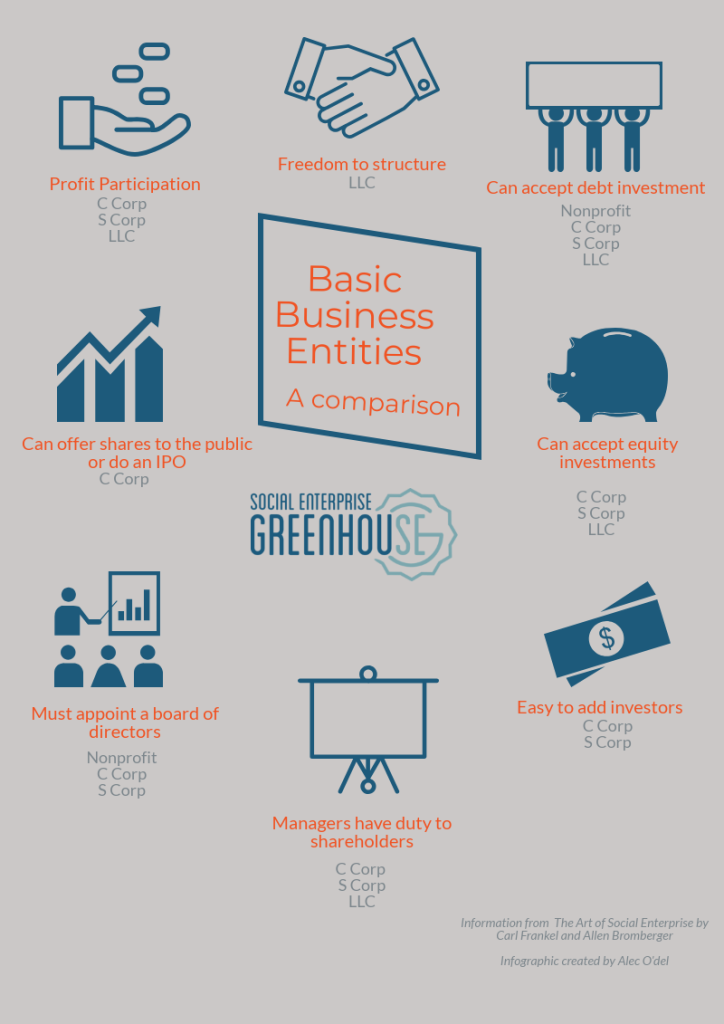By Alec O’del
Social enterprise, the idea of using business as a force for good, is on the rise. Many wonder how a company can pursue positive social impact, while remaining financially sustainable. Lawyers Carl Frankel and Allen Bromberger discuss social entrepreneurship and the different social enterprise corporate structures in their book The Art of Social Enterprise. Traditionally, businesses have prioritized profits first. On the other hand, non profits prioritize the mission, but are burdened by finding funds to keep their operations afloat. The field of social enterprise offers a middle ground between these two extremes: combining a positive social impact while generating profit.
The authors compare and contrast different forms of for-profit structures. The three main forms they note are the C corporation, the S corporation, and the Limited Liability Corporation (LLC). All three protect their owners from personal legal liability. The difference is how shareholders are taxed. In a C corporation, the company’s profits are taxed, and when profits are distributed to owners as dividend, dividends are taxed at the owner’s personal tax rate for investments, which is lower than the rate for ordinary income. An S corporation has no corporate tax on profits, instead the revenues and expenses go to owners. Owners therefore get taxed once only at personal income rate. An S corporation cannot have more than 100 shareholders and less than 25% of income can generate from passive activities like stocks. A third form, an LLC, lets anyone be an owner, including another LLC or corporation.
Another newer structure that can be ideal for a socially impactful business is a Benefit Corporation (B corporation). This hybrid structure has been passed in over 30 states as of May 2018. B corporations must state that it is pursuing a specific public goal. The corporation must also give an annual report about what it has done in the past year to achieve the social mission. B corporations are legally required to prioritize mission and profits at least the same, thus protecting them if their future business decisions help the mission but hurt profits. This is why owners of B corporations are more protected from liability than other legal forms. Benefit Corporations in Rhode Island as of this writing include Packaging 2.0, Increment, Rhode Races Events, Pease Editing Services, Hillandale Food Hub, Junto Studios Works Co., Collaborative Energy Options, and Worldways Social Marketing. This new form is still being tested in many states and the results are promising!
Funding is another key issue discussed in the book. The writers stress that entrepreneurs should “Ask for as much money as you need not a penny more” (77). Strategies like crowdfunding or social media can generate funds to help businesses get started. However businesses that need a larger sum to achieve their goals ($500,000+) require a more efficient means of acquiring money. Thus, entrepreneurs have two strong options when acquiring money for their business: rent or buy. Renting means receiving loans that are required to be paid back with interest. SEG, for example, has a loan fund that offers small loans with competitive interest rates to social entrepreneurs. They also provide free technical help to potential borrowers who need assistance assembling their loan package. Buying money refers to equity, gaining funds in exchange for selling a portion of their company. In this case, the entrepreneur would not have to pay monthly interest, however, they would have to pay back the investors later through dividends or liquidity (selling their entire company).
Choosing the right structure for your business can be daunting. Each business is different so there’s no right model for everyone. Luckily, we made an infographic to describe some of the qualities of each model. For more information on business models please read The Art of Social Enterprise.
Alec O’del
SEG Intern
Alec O’del has been running a part time chocolate business, O’Delicious! Chocolates ® since he was 10 years old. He is a senior at Rocky Hill School, and will be majoring in entrepreneurship and emerging enterprises at Syracuse University in the fall of 2018.


